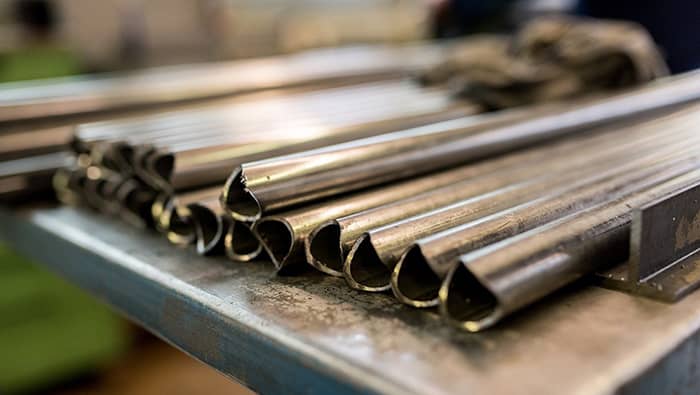Stainless steel has been in practice worldwide due to its excellent strength, corrosion resistance, aesthetic appearance, and durability. That’s why stainless steel is widely used in the best steel company in India. But how has steel become the most prominent metal from the scrap?
The majority of the stainless steel is prepared similarly. But the process of stainless steel is different and made with a combination of metals which enhances its property. Hence, to understand in detail, let’s read the post and learn how stainless steel is made from raw steel.

Contents
What is Stainless Steel?
Stainless steel is a mixture of steel, iron, chromium, nickel, and other elements. It is highly resistant to rust and delivers long-lasting performance. Since this is an eco-friendly material, it can be used repeatedly by recycling. Furthermore, it doesn’t easily oxidized or leach compounds, so it stays for a longer time.
Stainless steel is highly durable, sustainable, easy to maintain, and aesthetically appealing. This is why it is used in a myriad of industrial sectors, including construction, kitchen utensils manufacturing, transportation containers, shipbuilding, and more. Apart from this, stainless steel is also used to manufacture the best quality tmt bars in India.
History of Stainless Steel:
Harry Brearly of Sheffield in the United Kingdom discovered the rustles steel in 1919, which is today known as stainless steel. Before that, so many attempts have been made to make stainless steel. But Brearly took the credit for inventing the first stainless steel.
This steel contains 12.8% of chromium. He added chromium into the molten form of iron to produce a metal that doesn’t rust. Sooner, Sheffield became the name of the metallurgy and steel industry.
Brearley stumbled in discovering the best method to prevent the internal surface of the gun barrel from rusting for the British army. However, after this discovery of rusted steel, he further focused on improving the stainless steel. In 1919, a patent on martensitic stainless steel was obtained by Elwood Haynes.
On the other hand, in 1929, William J. Kroll of Luxembourg further discovered precipitation-hardening stainless steel, and duplex stainless steel was produced in 1930 At Avesta Ironworks in Sweden.
In the 1920s, a different variety of stainless steel was manufactured with chromium and nickel. In 1925, the companies used the stainless steel tanks to store nitric acid because of their unique metal resistance property. Stainless steel is also used in making fermenting vessels and surgical implants. Until today, stainless steel has come a long way and become immensely popular worldwide.
Why is Stainless Steel So Popular in Manufacturing?
Stainless steel is highly popular in the manufacturing industry of top tmt bars in India due to its several advantages. It has high resistance and withstands all weather conditions.
Stainless steel has high strength because it consists of a mixture of metals. Due to extreme stability, stainless steel is used in different industrial sectors such as shipbuilding, kitchen utensils formation, etc.
How Stainless Steel Is Made?
The stainless steel has been made by following this procedure.
Melting:
India’s best tmt bar company melts the scrap steel and other metals in an EAF (electric arc furnace). They use highly powerful electrodes to melt it. Stainless steel is recyclable, so many manufacturers also add 60% recycled steel while melting.
Removing of Carbon Content:
Carbon maintains the hardness and provides strength to the stainless steel. However, excessive carbon can create carbide precipitation when you are welding them.
Hence, carbon content is reduced by using AOD (Argon Oxygen Decarburization). The method uses argon gas to remove carbon. Another method is VOD (Vacuum Oxygen Decarburization), in which melted steel is transferred to the oxygen chamber to reduce the carbon.
Tuning:
Once the carbon is removed, the temperature homogenization and balancing are further done. This helps meet the exact requirement of grades. Further, samples are analyzed and tested to adjust the mixture until it meets standards.
Casting or Forming:
The molten steel is then transformed into a primitive shape. However, the exact shape of the final product will depend on the finalized product. The most common shapes are Billets, blooms, slabs, rods, and tubes. The shapes are then marked for easy identification.
The other process will be different and based on the grades of the stainless steel and its functions. The steel slabs will convert into plates; blooms will be converted into wires and bars.
Hot Rolling:
This process is performed at a high temperature. The temperature will be above the recrystallization point of the steel. It helps to hold the steel in rough shape. Moreover, the temperature is controlled throughout the process to give the right structure to the steel.
Cold Rolling:
Cold rolling is required to maintain the physical shape of the steel. Once the ideal shape is given, the temperature will be set below the recrystallization temperature. Multiple rollers have been used to provide a particular shape to the steel in this process. It is helpful to give a final finish to the steel.
Annealing:
After the cold rolling process, annealing is done. This process involves a cooling cycle and controlled heating because it helps maintain the steep’s softness and helps reduce internal stress.
Descaling/Picking:
This is helpful to remove the scales by using the acid bath. This is also known as acid pickling. Descaling is also done through an oxygen-free environment. Depending on the finished product, the metal might need to return to the rolling processing.
Cutting:
Once the shape is defined and the steel is ready, different batches of the steel are cut into different sheets to meet the requirements. Most manufacturers use mechanical methods such as circular knives, guillotine knives, and high-speed blades to cut the steel. For another form of cuttings, flame cutters and jet cutters are used.
Finishing:
Once cutting is done, the stainless steel is transferred into a mirror and matte form to offer different finishes. This is the last manufacturing step and commonly includes sand etching, belt grinding, sandblasting, and other processes.
Properties Of Stainless Steel:
Stainless steel has been used in widespread industrial applications due to its significant properties. It’s a mixture of chromium, alloy, and nickel, enhancing its sturdiness and making it suitable for manufacturing a variety of products. Some of the best properties of the stainless steel are as follows:
- Stainless steel is environment friendly
- It is highly durable and easy to recycle
- Corrosion-resistant
- High tensile strength
- Temperature resistant
- Low maintenance required
- Easy fabrication and formability
- Aesthetically appealing and withstand longer
What Is the Metal Combination in Stainless Steel – Composition of Stainless Steel
Stainless steel is made with metals such as nickel, iron, chromium, and others. It consists of 10.5-30% of chromium, 30 % of nickel, 1-2% of carbon, and other alloys.
However, there is a different form of stainless steel available in which the composition of the metal is different. For instance, in stainless steel 304-grade types, there is 18% of chromium and 8% of nickel.
What Are The Types Of Stainless Steel?
There are generally four types of stainless steel used in manufacturing the best quality tmt bars in India. These are as follows:
1. Ferritic Stainless Steel
This type of steel contains 30% chromium and 0.1% of carbon. It has low carbon consistency as compared to other forms of stainless steel. Moreover, it also has magnetic properties and is mainly chosen for its resistance to temperature and rusting.
2. Austenitic
The austenitic form of stainless steel is used to manufacture the top ten tmt bars in India. It contains nickel, molybdenum, and chromium. This stainless steel is versatile enough to mold in different shapes and designs because it has high malleability and strength.
3. Duplex
This stainless steel is made by combining ferritic and austenitic steel. This is one of the strongest forms of stainless steel available that helps manufacture the top 10 Saria brands in India. Its high strength can also lead to a reduction in weight. Moreover, it is highly resistant to corrosion and extremely worthier in construction areas and marine applications.
4. Martensitic
This stainless steel is similar to the ferric type but has more carbon content than another form of stainless steel. It can be hardened to different degrees. This kind of stainless steel is generally used in making surgical instruments and tools.
What are the Uses of Stainless steel?
Stainless steel is the most vital component of the construction industry and the best rod company in India. Nowadays, no product doesn’t contains stainless steel. All industries use stainless steel for manufacturing products, from refrigerators to products and washing machines to bridges and ships to utensils.
The best thing about stainless steel is you can use them even after recycling to manufacture different products without losing their property. The most common use of stainless steel are as follows:
- Food and catering utensils
- Offshore technology
- Sea desalination plants
- Chemical industry
- Bridges
- Shipbuilding plants
- Power plants
- Civil engineering
Why does stainless steel not rust?
Stainless steel consists of a chrome and nickel mixture, so it doesn’t trust easily. The chromium in the steel reacts with oxygen and makes a strong reactive covering on the steel. This is why they do not rust easily.
How To Remove Rust From Stainless Steel?
The best way to remove rust from the stainless steel is baking soda, water, and lemon juice mixture.
- Take half a cup of vinegar and add two cups of water.
- Add one lemon juice.
- Use a toothbrush to rub the mixture on the stainless steel.
- Leave it aside for a few minutes and wash it gently with lukewarm water.
- You can also add detergent to the mixture to get better results.
Which type of stainless steel is Weldable?
Ferritic, Austenitic, and duplex stainless steel are some of the top Tmt bars in India that are weldable. Ferritic stainless steel is an eagerly weldable form of steel. It contains chromium and other alloy elements, making it more weldable than other forms of stainless steel.
Frequently Asked Questions:
Stainless steel is made by adding chrome, carbon, and nickel to make it stainless steel. The ratio may be different or based on the process used.
Tungsten is the component that is not used in stainless steel.
18 8 grade steel is made with 18% Chromium and 8% nickel. Moreover, there is 50% iron and 0.8% carbon.
Mixture of baking Soda and water is used to remove the acid stain from stainless steel. However, wear gloves while using the method because it may release an acid that can harm your hands.
Grade 304 stainless steel is the most popular and common steel made with nickel and chromium. Since this is a non-iron constituent, it has less thermal conductivity than others.
Mini grinder and vinegar solution are best to polish the stainless steel.
Tiply stainless steel constitutes three layers: copper, steel, and aluminum, which give them sturdiness and better conductivity.
Conclusion:
This is all about what stainless steel is and how it is made. Understanding the stainless steel, type, manufacturing process and specific uses can help to determine where you can use the stainless steel for long-lasting results.
The smooth surface of the stainless steel provides high corrosion resistance. Different polishing methods are used to polish the steel surface, further enhancing durability.
Whether you need the best Tmt bars or Saria brand, stainless steel and alloy are available for everyone. And we are here to guide you to get the best stainless steel that meets your requirements.
Hi, This is Ayush Badhoni a passionate blogger from India, loves in researching and writing on various topics like home appliances, gadgets, beauty e.t.c I love to review products and give the best to my readers.
